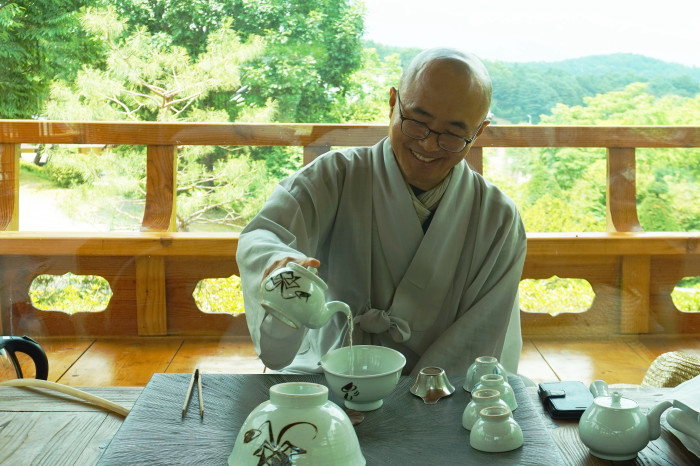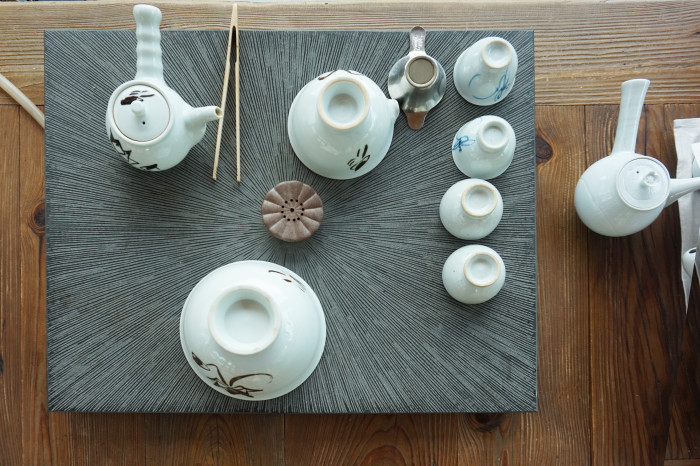GGC
Gapyeong_Local interview : Baengnyeonsa Temple
Buddhist Monk Hyoman Sunim of <Baengnyeonsa Temple> in Gapyeong
There is a place that comes to mind whenever life gets tough and complicated – a tranquil and lonesome temple. A beam of hope that all of my worries will be completely washed away here is perhaps the reason for many to visit and stay. I visited Baengnyeonsa Temple in Gapyeong, not too far from the Seoul metropolitan area, to ask Monk Hyoman about the ways to maintain calmness, his daily life, and temple stay.

Hello, Monk Hyoman. It is my pleasure to meet you. It is surprising that a quiet Buddhist temple is located fairly close to the city center of Seoul. Could you please introduce to us Gapyeong Baengnyeonsa Temple?
Baengnyeonsa Temple is a bit older than 20 years of age, which makes it relatively young temple. Because it is a place where not many people visit like a tourist attraction but, instead, a small number of believers and citizens come to pray, it provides a time for quiet relaxation and asceticism. On weekends, a good number of people visit the temple during their hike, but it is more quiet and secluded on weekdays. The means of transportation is also good as it is only about 1-hour away from Seoul by car.
If I were to choose one charm of our temple, it would be the nut pine forest path of Chungnyeongsan Mountain. The phytoncides and scents oozing out of the nut pine trees that surround the temple make our bodies and minds healthier. It takes about 3 hours for a light walk of meditation, but it is not a strenuous stroll as the entire path is flat. We monks often take the walk of meditation here with those on a temple stay.

I heard that you first became a Buddhist monk at Baengnyeonsa Temple. Was there a specific reason?
There was no special reason. I learned of Baengnyeonsa Temple from another monk and became a Buddhist monk myself here in 2007. In the Buddhist world, there is a teacher monk and, if you are given a Buddhist name from him, you become his “son.” When you first become a monk, you know nothing so, like a parent in the secular world, the teacher takes care of the future of his son. My Buddhist name is “Hyoman,” which combines Hyo (曉), or “enlightened at the dawn, and Man (晩), or “late”. The name means “study hard thinking that even dawn is late” and “be enlightened even if it is late”, the former of which is the meaning that my teacher monk thought of when giving me the name.
I am curious to know the daily life of a Buddhist monk, which must be quite different from a typical city person.
We begin our Buddhist service at 4 a.m. during which we hold a ritual to wake all living creatures still asleep and also perform jongseong for propagation of Buddha’s teachings to the world while striking a large bell. Once the service and prayer end at about 5:30 a.m., we have breakfast, also called jogong, at 6 a.m. After the meal, we all spend some personal time until 9:50 a.m. when we start sasibulgong, a prayer of offering to Buddha between 9 and 11 a.m., a time period traditionally known as sasi, that lasts about 1 hour and 30 minutes. We then have lunch at 11:30 a.m. and spend some more time on our own until 6 p.m. when an evening offering prayer is performed. From 7 to 8:30 p.m., we hold another service and finish our days by going to sleep at around 9 p.m.
What are some of the sayings or passages that you have come to love during your study?
There are many good words and passages in Buddhism. One that I like is written in Uhwajeong (teahouse) that we are in right now. What do you think this means?
夜有夢者不入, 口無舌者當主 (Yayumongjaburip, Gumuseoljadangju)
One with a dream at night cannot enter and one without a tongue in the mouth may stay.
Those with many dreams at night also have as much delusion and agony. An ascetic’s thoughts must be simple and honest like the amount of things he or she possesses so they must not have dreams at night. Also, an ascetic is a person without words. Those who are talkative often have their thoughts scattered outside so do not have an opportunity for thoughts to stay in and mature. Silence and virtue must be a second nature.
In the Buddhist world, there is a saying that, before you come over Iljumun Gate, you must let go of all knowledge or wisdom of the secular world because it is useless. Buddhism is to study diligently while doing away with all of the pride and arrogance.
People who visit a temple or come for a temple stay are often filled with worries or anger in their hearts. I would like to know how you typically maintain calmness.
If you build anger in your heart, it causes a disorder so Buddhism teaches us to digest anger in any way possible.
When most people become upset, however, they are ready to shoot arrows at the other person so a fight intensifies. In such cases, it is good to take some time off to reduce the degree of anger you have. Like you have said, just going to sleep may be one way to do so.
When a Buddhist monk becomes angry, he goes into his inner side. It is not to complain about why the other person is upset at you but, rather, to observe and research how I react to the other person’s angry confrontation. The same concept applies to whenever we encounter a boundary. Rather than seeing the person we meet, we think why he or she has come into our sphere to be happy, sad, angry or react within such boundaries. Buddha teaches to see within, not in front of, me, which is also related to calmness.

I heard that it has been about 10 years since Baengnyeonsa Temple first began a temple stay. How is it being operated?
We began our temple stay program on April 19th, 2008. As the name suggests, a temple stay allows one to stay at a temple to experience daily lives of a temple and use it as a turning point for changes in his or her life in the world. It can be divided into relaxation type and experience type.
At first, most people chose the temple experience (experience type). The program comprised everything from a dawn service and 108 bows to chamseon (meditation) and balwoo gongyang (communal Buddhist meal service) but the participants had a difficult time. Many people want relaxation, rather than experience, so, now, our temple stay is mostly operated with the relaxation type. Though it has deviated a bit from the original purpose, it is still an experience for people to observe the lives of monks in the closest distance, so I believe they will return home with their own enlightenment after completing a temple stay.
Many people visit a temple when their lives and minds are difficult and fatigued. Is it similar for the temple stay?
If we look at age groups, the largest percentage of those who participate in temple stays is in their 20s and 30s who knock on our door with a variety of concerns such as work life, personal relations, employment, or relationships. They wish to share their worries and listen to the wisdom of our guidance monk over a cup of tea but, more often than not, they already know the answers to their problems. They just want to be confirmed by someone else.
Temple stays are run as the experience type on weekends and the relaxation type on weekdays. We allow people to participate in various programs even if they are on the relaxation temple stay, and many of them whose issues that had been sitting on their hearts visit again after reaching a satisfying resolution, which deepens their ties to Baengnyeonsa Temple. It is true that we have our own concerns as we have drifted somewhat from the original purpose of the temple stay but, no matter what the type is, I believe our temple stay serves an important role in transforming daily lives of those who visit the temple and observe the lives of Buddhist monks.
Written and photos by Kim Sun-joo
Website http://www.baekryunsa.org/
<Copyright(c)2002 GGC All rights reserved.>
information
Gapyeong Baekryunsa Temple
Address/ 159-50, Saemgol-gil Sang-myeon, Gapyeong-gun, Gyeonggi-do
Contact/ 031-585-3853
Website/ http://www.baekryunsa.org/
- Writer
- About
You might like
Location around
Namyangju_Local interview : Museum of Silhak
Jang Deok-ho, Director of <Museum of Silhak> in Namyangju
THE FORMATION AND DEVELOPMENT OF KOREAN SILHAK, ASTRONOMY AND GEOGRAPHY
3. Silhak and science (astronomy and geography)
The person who lives the moment
September 1, 2018 - December 31, 2018 / Actress Seo Yi-suk
THE FORMATION AND DEVELOPMENT OF KOREAN SILHAK, ASTRONOMY AND GEOGRAPHY
1. Formation of Silhak